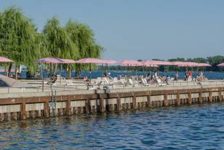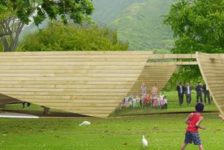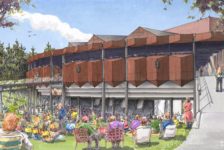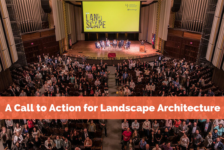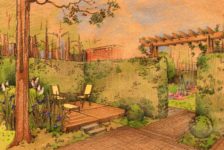In recent years one topic gains more and more popularity – agriculture in big cities and how it relates to landscape architecture. Today it is considered to play a critically important role in sustainable development and it covers all components of sustainability: economy, society and environment. Urban agriculture can be seen from very different perspectives and can take on very different forms. These include; community , collective , roof and private gardens; organic farming and farms serving local markets or even broader regional and national scales. It is increasingly recognised for its benefits to urban society. In time of crises and urbanization, we should ask ourselves if we can challenge what we take for granted, what we think is obvious and embrace a more creative point of view. Can we relocate the usual picture of the vegetable garden in the end of our backyard, hidden from the outside world and instead, put it in a public place. In a broader view, how can we promote agrarian land as an attractive and desirable place for recreation? To illustrate this, I would like to show a design from Shlomo Aronson Architects, a team of landscape architects, planners and architects from Israel and their project for Ben Gurion International Airport. What an exemplary model from a city that is ranked as one of the greenest in Israel. The airport is located 19 km southeast of Tel Aviv’s city center and is one of the biggest in the region. It is located in an agricultural area and the team takes advantage of this. The approach they use is to strongly integrate the airport to its surroundings of citrus groves and agricultural fields. The central garden is designed to remind visitors of its natural landscape features with its particular topography and man-made agricultural development. The vegetation is based on olive groves, grasslands and wheatfields, mixed with more typical planting such as palms. Of course, we need a water element to finish this unique piece of design. The different shapes and textures create the diversity needed for a good garden design. Thus, production and beauty are well combined and balanced. No one can argue that inspiration for garden designs can be found in agriculture. However, my aim is to encourage a broader use of that type of land. How can we integrate vast fields of agricultural lands and at the same time propose to urban society that it can be a place for recreation? One way is to present it as an aesthetic and cultural asset and put it on stage. Employ public infrastructure and create seating points and vistas. Belvedere Park, Cologne is a project that exemplifies such an approach. Vast fields of sunflowers, lavender, cole, vineyards and cherries. The list is as large as our imagination. One unexpected face of agriculture is Farmersgolf. Have you ever heard of it? It is a type of golf played in farmswith specific instruments found on farms. For example, a golf hole is made by placing a bucket on the ground and obstacles can include cows, ditches or barbed wire. The ball is much bigger than the usual golf ball and the head of the club is shaped like a shoe. ? It has been played since 1999 and is popular in Germany, France, Belgium and Sweden. It is the result of costly golf fees in the Netherlands and a test should be passed before being allowed to play. This is what we can call a return to nature. Agriculture nowadays has multiple functions that include the conservation of cultural heritage landscapes, agricultural and landscape recoursesand leisure, tourist and educational activities. Ranging from visits by school children, workshops on healthy eating and preparation of food, to more unconventional activities like Farmersgolf. Can you think of another creative way to use productive land in everyday life? Article written by Slavyana Popcheva
Published in BlogLogin
Lost Password
Register
If this is your first time on the new site, please click "Forgot your password?". Follow the steps to reset your password. It may be the same as your old one.


